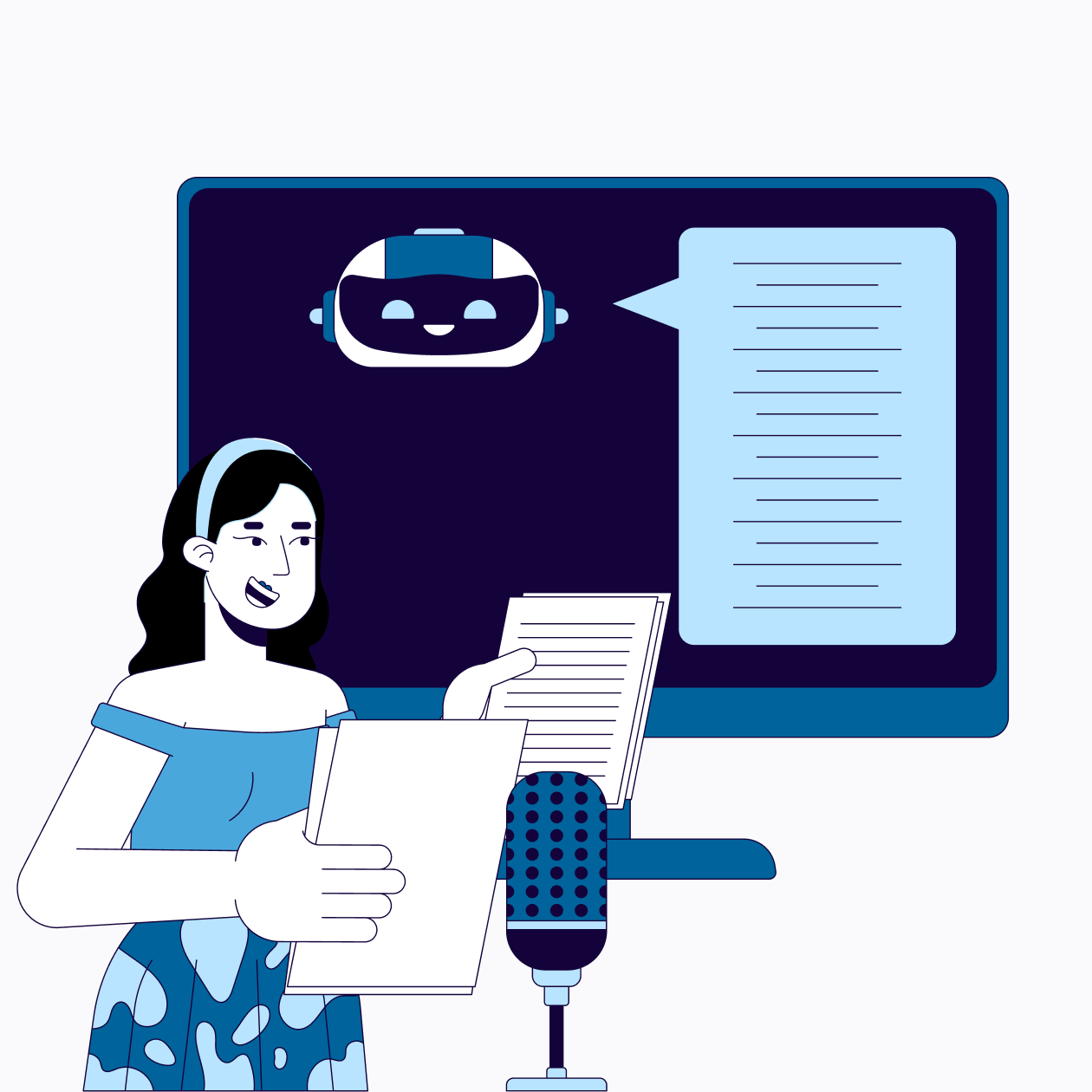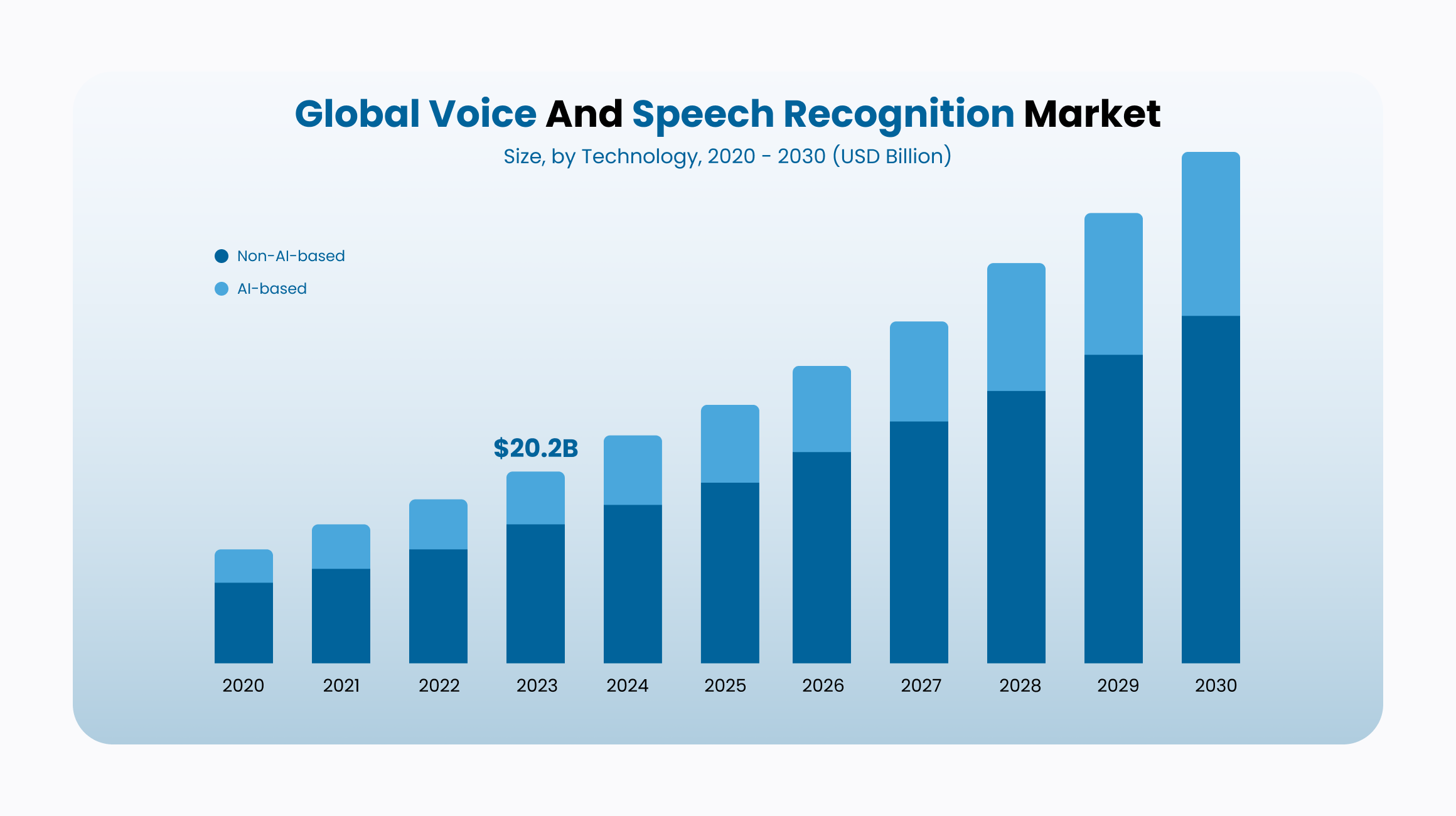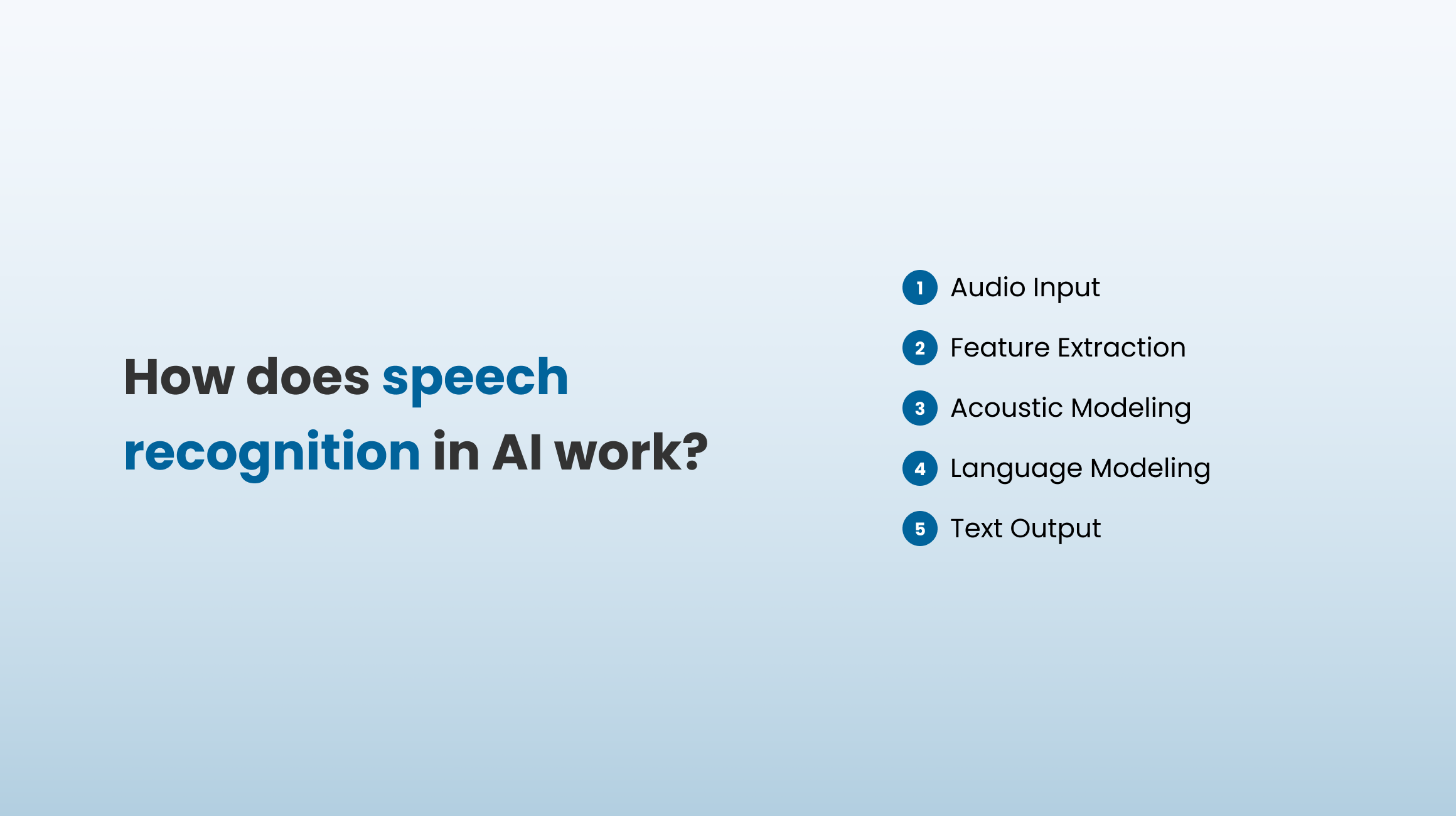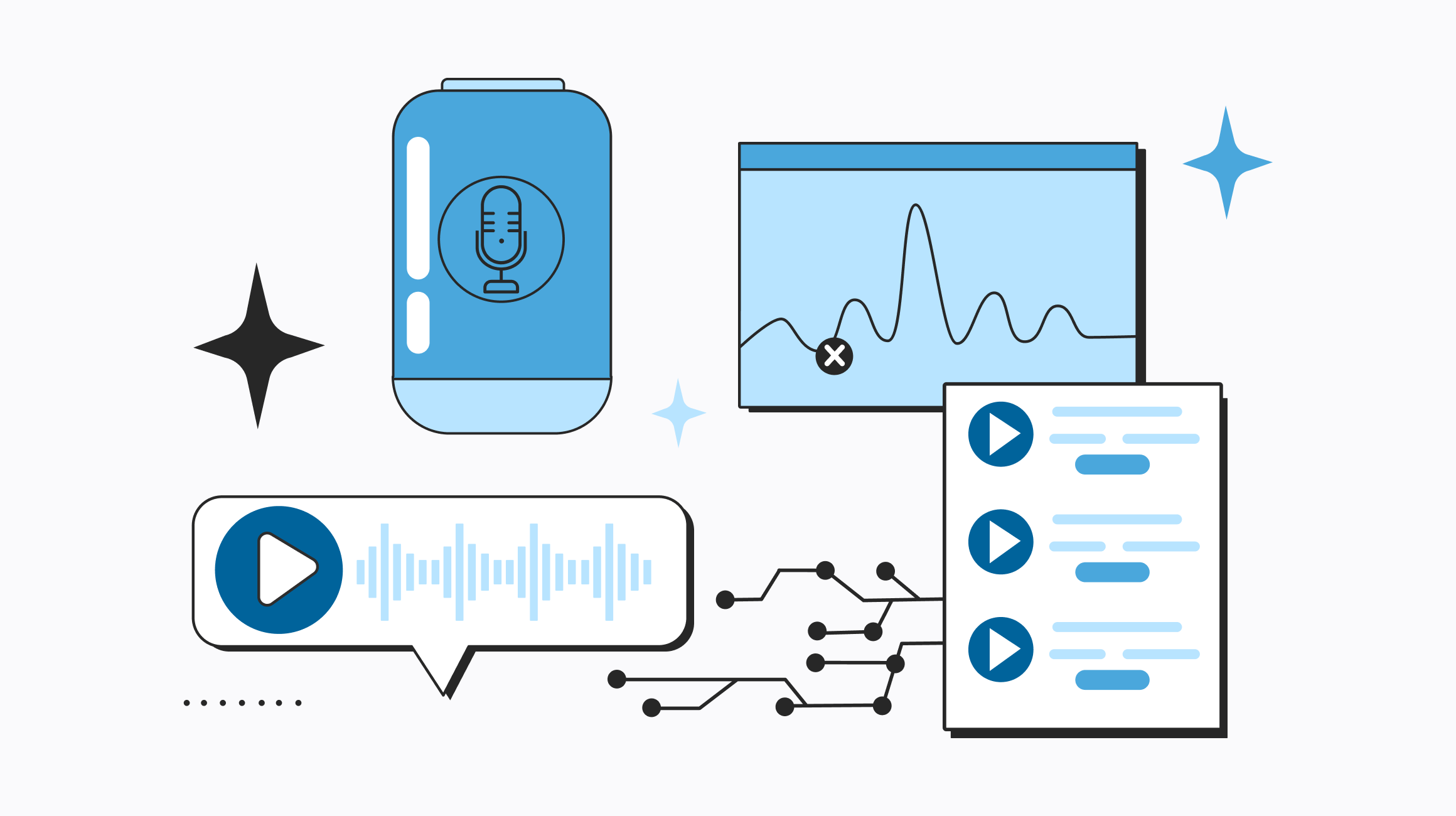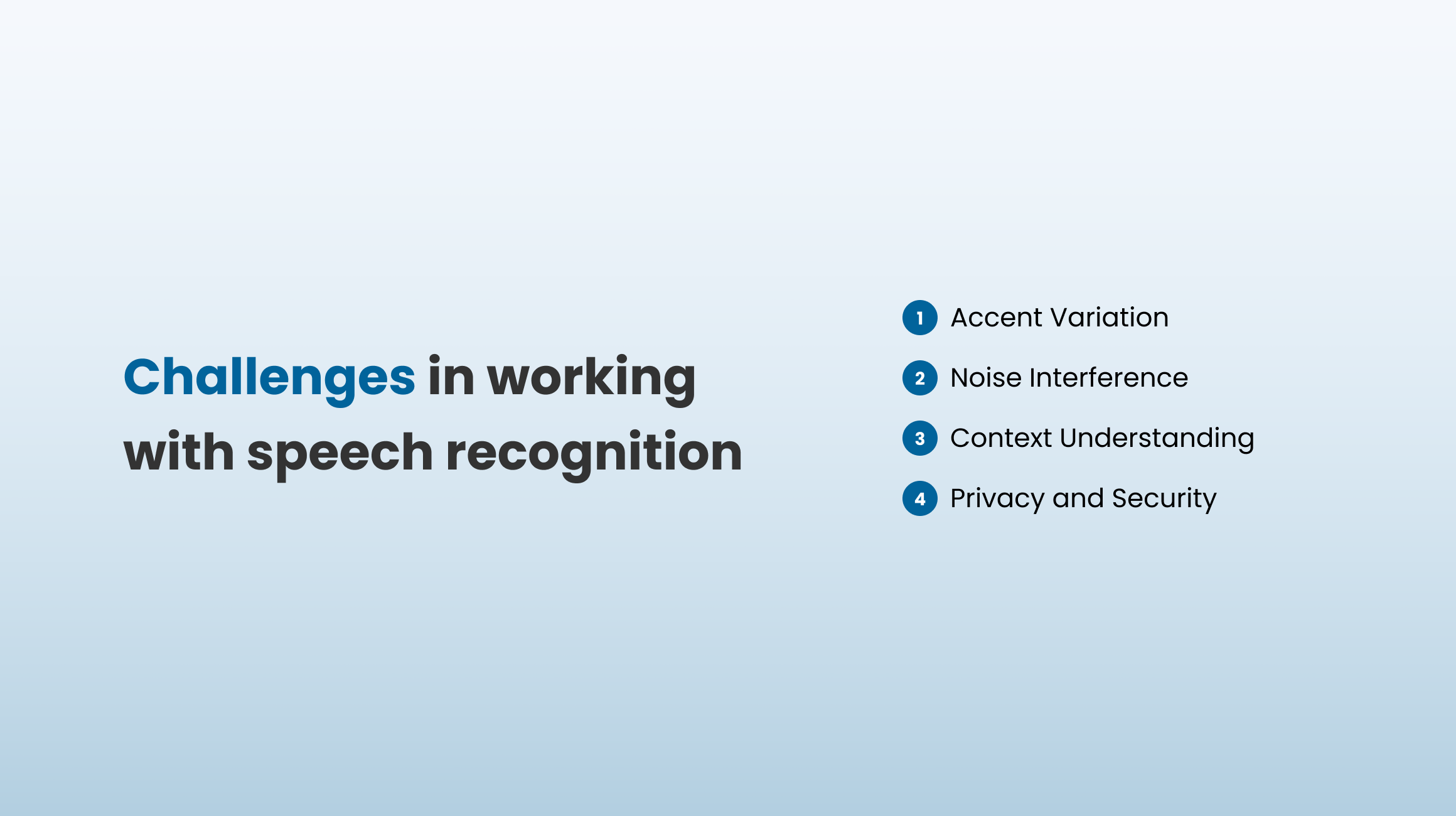- What we do 我們做什麼
- Services 服務業
- Solutions 解決方案
- Our Works 我們的作品
- Insights 見解
- Company 公司
- Contact Us 聯繫我們
October 17, 2024 10月17, 2024
Speech Recognition in AI AI 中的語音辨識
Delve into the world of speech recognition technology in artificial intelligence with this comprehensive article. Explore how speech recognition works and its significant role in enhancing human-machine interactions.
通過這篇全面的文章深入研究人工智慧中的語音辨識技術世界。探索語音辨識的工作原理及其在增強人機交互方面的重要作用。
Speech recognition technology is becoming a vital component in improving human-machine interactions. According to research, the global speech and voice recognition market is expected to grow from $10.9 billion in 2022 to $49.79 billion by 2030, reflecting its growing demand across numerous industries. Additionally, as of 2023, about 62% of U.S. adults use voice-activated assistants such as Siri, Alexa, or Google Assistant, highlighting its widespread adoption in both personal and business environments. This showcases that speech recognition is becoming increasingly mainstream and streamlining business interactions with Automatic Speech recognition (ASR) is crucial.
語音辨識技術正在成為改善人機交互的重要組成部分。根據研究 ,全球語音和語音辨識市場預計將從 2022 年的 109 億美元增長到 2030 年的 497.9 億美元,這反映了眾多行業的需求不斷增長。此外,截至 2023 年,約 62% 的美國成年人使用 Siri、Alexa 或 Google Assistant 等聲控助手,凸顯了它在個人和商業環境中的廣泛採用。這表明語音辨識正日益成為主流,使用自動語音辨識 (ASR) 簡化業務交互至關重要。
來源:Grand View Research
In this article, we’ll explore how speech recognition in AI is transforming our work and personal lives by making tasks easier with simple voice commands. We’ll dive into how this technology works, its impact on our daily routines, and the challenges it faces. Plus, we’ll show you why teaming up with Yellow for AI solutions can make all the difference.
在本文中,我們將探討 AI 中的語音辨識如何通過簡單的語音命令簡化任務來改變我們的工作和個人生活。我們將深入探討這項技術的工作原理、它對我們日常生活的影響以及它面臨的挑戰。此外,我們還將向您展示為什麼與 Yellow 合作的 AI 解決方案可以帶來重大變化。
What is Speech Recognition in AI?
什麼是 AI 中的語音辨識?
AI speech recognition software enables computers and other devices to comprehend and process spoken language. This technology is powered by advanced machine learning algorithms and neural networks that have been trained on vast datasets of human language. From recognizing individual words to understanding complex sentences, AI-driven speech recognition systems have evolved to become more accurate and reliable, making them integral to various applications, including virtual assistants and voice-controlled devices.
AI 語音辨識軟體使電腦和其他設備能夠理解和處理口語。這項技術由先進的機器學習演算法和神經網路提供支援,這些演算法和神經網路已在大量的人類語言數據集上進行了訓練。從識別單個單詞到理解複雜的句子,AI 驅動的語音辨識系統已經變得更加準確和可靠,使其成為各種應用程式(包括虛擬助手和語音控制設備)不可或缺的一部分。
Empower business growth—Invest in AI development for a competitive edge.
促進業務增長 — 投資於 AI 開發以獲得競爭優勢。
How Does Speech Recognition in AI Work?
AI 中的語音辨識如何工作?
The process of speech recognition involves several key steps, they include:
語音辨識的過程涉及幾個關鍵步驟,它們包括:
Audio Input: When you speak to a device, your voice is picked up by a microphone. This audio serves as the input for the speech recognition system.
音訊輸入:當您與設備通話時,您的聲音會被麥克風拾取 。此音訊用作語音辨識系統的輸入。Feature Extraction: The recorded sound is then analyzed and broken down into smaller parts called "features." These features help the system understand different aspects of the sound, like pitch and tone.
特徵提取:然後對錄製的聲音進行分析並分解為更小的部分,稱為“特徵”。這些功能可幫助系統理解聲音的不同方面,例如音高和音調。Acoustic Modeling: Deep learning models, particularly neural networks, analyze these features to recognize phonemes, the smallest sound units. For example, the sounds "s" in "sun" and "h" in "hat" are different phonemes.
聲學建模:深度學習模型(尤其是神經網路)會分析這些特徵以識別音素,即最小的聲音單位。例如,“sun” 中的“s”和 “hat” 中的“h”是不同的音素。Language Modeling: After identifying the phonemes, the system uses a language model to put these sounds together into words and sentences. The language model helps the system figure out which words and sentences make sense based on the context.
語言建模:識別音素后,系統使用語言模型將這些聲音組合成單詞和句子。語言模型可幫助系統根據上下文確定哪些單詞和句子有意義。Text Output: Finally, the recognized words are transcribed into text, which can be used for various applications, from transcription to voice commands to performing actions. For instance, if you say "Set a timer for 10 minutes," the system will understand this command and set a timer accordingly.
文本輸出: 最後,將識別的單詞轉錄成文本,可用於各種應用程式,從轉錄到語音命令再到執行作。例如,如果您說 「Set a timer for 10 minutes」,系統將理解此命令並相應地設置計時器。
Speech Recognition AI and Natural Language Processing
語音辨識 AI 和自然語言處理
Natural Language Processing (NLP) plays a vital role in the functioning of speech recognition. While Automatic Speech Recognition (ASR) is responsible for converting spoken words into text, NLP steps in to ensure that this text makes sense in context. Without NLP, the text produced by ASR might be accurate in terms of the words themselves, but it could lack the correct meaning or understanding of the spoken language’s nuances.
自然語言處理 (NLP) 在語音辨識的功能中起著至關重要的作用。雖然自動語音辨識 (ASR) 負責將口語轉換為文本,但 NLP 會介入以確保這些文本在上下文中有意義。如果沒有 NLP,ASR 生成的文本在單詞本身方面可能是準確的,但它可能缺乏正確的含義或對口語細微差別的理解。
How NLP Enhances Speech Recognition
NLP 如何增強語音辨識
NLP is the part of AI that deals with understanding and interpreting human language. It ensures that the transcribed text is not only correct in terms of words but also meaningful and contextually appropriate. Here's how NLP works hand-in-hand with speech recognition:
NLP 是 AI 的一部分,用於理解和解釋人類語言。它確保轉錄的文本不僅在單詞方面是正確的,而且有意義且上下文適當。以下是 NLP 與語音辨識的工作原理:
Understanding Context: Spoken language can be ambiguous. Words that sound the same but have different meanings, known as homophones, can easily confuse basic speech recognition systems. For example, the word "bat" could refer to the flying mammal or the equipment used in baseball. NLP helps the system determine the correct meaning by analyzing the context in which the word is used.
理解上下文 :口語可能是模棱兩可的。發音相同但含義不同的單詞(稱為同音字)很容易混淆基本的語音辨識系統。例如,“bat”一詞可以指飛行的哺乳動物或棒球中使用的設備。NLP 通過分析使用單詞的上下文來幫助系統確定正確的含義。
Handling Ambiguities: Sometimes, a spoken phrase can have multiple interpretations. NLP algorithms analyze the sentence structure, surrounding words, and overall context to resolve these ambiguities. For instance, in the sentence, "Set an alarm for two," the word "two" could be transcribed as "2," "to," or "too." NLP looks at the surrounding words and the general context of the conversation to determine that "two" refers to the time, not a direction or agreement.
處理歧義 : 有時,一個口語短語可以有多種解釋。NLP 演算法分析句子結構、周圍單詞和整體上下文以解決這些歧義。例如,在句子“Set an alarm for two”中,單詞“two”可以轉錄為“2”、“to”或“too”。NLP 查看周圍的單詞和對話的一般上下文,以確定“二”指的是時間,而不是方向或協定。
Improving Accuracy: NLP doesn’t just stop at understanding individual words. It also looks at entire sentences to ensure the text is accurate. This includes recognizing and correctly interpreting grammar, idioms, slang, and other language nuances that might confuse a less sophisticated system.
提高準確性:NLP 不僅僅停留在理解單個單詞。它還會查看整個句子以確保文本準確無誤。這包括識別和正確解釋語法、習語、俚語和其他語言細微差別,這些細微差別可能會使不太複雜的系統感到困惑。
Contextual Learning: Modern NLP systems can learn from context over time. For example, if you often use the phrase “Set an alarm for two,” the system might learn that "two" in this context always refers to the time and adjust its interpretation accordingly. This ability to learn and adapt makes NLP-powered systems more accurate and user-friendly.
情境學習: 現代 NLP 系統可以隨著時間的推移從上下文中學習。例如,如果您經常使用短語 「Set an alarm for two」,則系統可能會瞭解到此上下文中的 「two」 始終是指時間,並相應地調整其解釋。這種學習和適應能力使 NLP 驅動的系統更加準確和使用者友好。
Learn about how AI is transforming the educational industry.
瞭解 AI 如何改變教育行業。
Read more 閱讀更多Example in Action 實際作示例
Consider the phrase "Let's meet at two." A basic ASR system might simply transcribe the spoken words into the text as "Let’s meet at 2," "Let’s meet at to," or even "Let’s meet at too," without understanding the intended meaning. Here’s where NLP steps in:
考慮一下這句話 “Let's meet at two.”基本的 ASR 系統可能只是將口語轉錄為“Let's meet at 2”、“Let's meet at to”甚至“Let's meet at too”,而不理解其原意。以下是 NLP 的用武之地:
NLP Analysis: The NLP component analyzes the sentence, recognizing that “meet” suggests an event or appointment and that “two” likely refers to a time.
NLP 分析 :NLP 元件分析句子,識別出“meet”表示事件或約會,而“two”可能是指時間。Contextual Decision: Based on the surrounding words and the sentence structure, NLP determines that "two" should be interpreted as "2," representing the time of the meeting.
情境決策: 根據周圍的單詞和句子結構,NLP 確定“two”應解釋為“2”,代表會議的時間。Output: The final output text is "Let’s meet at 2," which is contextually accurate and meaningful.
輸出: 最終輸出文本是 「Let』s meet at 2”
Use Cases of Speech Recognition AI
語音辨識 AI 的案例
In terms of speech recognition technology has found applications across various domains, enhancing user experiences and streamlining operations.
在語音辨識方面,技術已在各個領域得到應用,增強了用戶體驗並簡化了作。
Google Assistant 谷歌助理
Google Assistant leverages speech recognition using AI to understand and respond to voice commands. From setting reminders to controlling smart home devices, Google Assistant offers a hands-free experience powered by deep learning algorithms that continuously improve its accuracy and responsiveness.
Google Assistant 利用 AI 的語音辨識來理解和回應語音命令。從設置提醒到控制智慧家居設備,Google Assistant 提供由深度學習演算法提供支援的免提體驗,不斷提高其準確性和回應能力。
Usage: As of 2023, Google Assistant is used by over 500 million people monthly. Common use cases include setting reminders, controlling smart home devices, navigating, and answering questions.
用法 : 截至 2023 年,每月有超過 5 億人使用 Google Assistant。常見案例包括設置提醒、控制智慧家居設備、導航和回答問題。
Amazon Alexa 亞馬遜 Alexa
Amazon Alexa is another popular voice-activated assistant that uses speech recognition AI to perform tasks, answer questions, and control smart devices. Alexa's ability to understand different accents and dialects makes it a versatile tool for users worldwide.
Amazon Alexa 是另一種流行的聲控助手,它使用語音辨識 AI 來執行任務、回答問題和控制智慧設備。Alexa 能夠理解不同的口音和方言,這使其成為全球使用者的多功能工具。
Usage: Alexa is installed on over 100 million devices globally. Common use cases include playing music, controlling smart home devices, shopping, and managing calendars.
用法 :Alexa 安裝在全球超過 1 億台設備上。常見使用案例包括播放音樂、控制智慧家居設備、購物和管理日曆。
Apple Siri 蘋果 Siri
Apple's Siri uses speech recognition to offer voice-activated assistance across Apple devices. Whether you're sending a text, searching the web, or setting up a meeting, Siri's speech recognition capabilities are designed to understand natural language and provide accurate responses.
Apple 的 Siri 使用語音辨識在 Apple 設備上提供聲控説明。無論您是發送文本、搜索 Web 還是安排會議,Siri 的語音辨識功能都旨在理解自然語言並提供準確的回應。
Usage: Siri is used by over 375 million active users each month. Common use cases include sending texts, searching the web, setting alarms, and controlling Apple HomeKit devices.
使用方式 :每月有超過 3.75 億活躍使用者使用 Siri。常見用例包括發送文本、搜索 Web、設置鬧鐘和控制 Apple HomeKit 設備。
Microsoft Cortana
Microsoft Cortana is a digital assistant that uses speech recognition AI to help users manage tasks, search for information, and interact with their devices. Cortana's integration with Microsoft's suite of applications makes it a powerful tool for personal and professional use.
Microsoft Cortana 是一款數位助理,它使用語音辨識 AI 來幫助使用者管理任務、搜索資訊以及與他們的設備交互。Cortana 與 Microsoft 應用程式套件的集成使其成為個人和專業用途的強大工具。
Usage: Cortana has seen widespread adoption in enterprise settings, with millions of users worldwide. Common use cases include managing tasks, searching for information, setting reminders, and integrating with Microsoft Office.
用法 : Cortana 已在企業環境中得到廣泛採用,在全球擁有數百萬使用者。常見用例包括管理任務、搜索資訊、設置提醒以及與 Microsoft Office 集成。
Benefits of Speech Recognition for Your Business
語音辨識對您的業務的好處
Increased Efficiency: Automating tasks through voice commands can save lots of time, so the employee may focus on higher-priority tasks.
提高效率: 通過語音命令自動執行任務可以節省大量時間,因此員工可以專注於優先順序更高的任務。Enhanced User Experience: Voice-activated systems provide a seamless, hands-free experience, improving customer satisfaction and engagement.
增強的用戶體驗: 聲控系統提供無縫、免提的體驗,提高客戶滿意度和參與度。Cost Savings: AI-powered speech recognition can reduce the manual process, thereby reducing operational costs and smoothing the workflows.
節省成本 :AI 驅動的語音辨識可以減少手動過程,從而降低運營成本並簡化工作流程。Better Accessibility: Speech recognition technology makes your services easier for more people to use, including those with disabilities.
更好的可訪問性: 語音辨識技術使更多人(包括殘障人士)可以更輕鬆地使用你的服務。Improved Data Insights: Voice interactions build relevant data, which can be analyzed to infer the behavior of customers and their likes. This serves as the guideline for changing business services for the better.
改進的數據洞察: 語音交互構建相關數據,這些數據可以被分析以推斷客戶及其點讚的行為。這是使商業服務變得更好的指南。
Challenges in Working with Speech Recognition AI
使用 Speech Recognition AI 的挑戰
While speech recognition with conversational AI has made significant strides, it still faces several challenges that need to be addressed to improve its accuracy and reliability.
雖然使用對話式 AI 進行語音辨識已經取得了重大進展,但它仍然面臨一些需要解決的挑戰,以提高其準確性和可靠性。
Accent Variation: Different accents can affect pronunciation, intonation, and rhythm, making it difficult for AI systems to accurately transcribe speech. This challenge requires continuous training of AI models with diverse datasets to improve their ability to understand various accents.
口音變化: 不同的口音會影響發音、語調和節奏,使 AI 系統難以準確轉錄語音。這一挑戰需要使用不同數據集持續訓練 AI 模型,以提高它們理解各種口音的能力。Noise Interference: Background noise is one of the biggest obstacles for speech recognition systems. The AI has to pick out your voice from all the other sounds around you, and if it gets it wrong, the result can be a string of gibberish instead of the command you intended. While some advanced systems are getting better at filtering out background noise, it’s still an area where many voice recognition tools struggle.
雜訊干擾: 背景雜訊是語音辨識系統的最大障礙之一。AI 必須從你周圍的所有其他聲音中挑選出你的聲音,如果它弄錯了,結果可能是一連串的胡言亂語,而不是你想要的命令。雖然一些高級系統在過濾背景噪音方面越來越好,但這仍然是許多語音辨識工具難以解決的領域。Context Understanding: Context is everything in conversation. Without understanding the context, the AI might not get your command right. NLP helps the system figure out what you mean, even if the words can be interpreted in multiple ways. But even with advanced NLP techniques, speech recognition AI sometimes misses the mark, especially with complex sentences or phrases that rely heavily on context.
上下文理解: 背景是對話中的一切。如果不瞭解上下文,AI 可能無法正確執行您的命令。NLP 幫助系統弄清楚您的意思,即使這些單詞可以用多種方式解釋。但是,即使使用先進的 NLP 技術,語音辨識 AI 有時也會錯失目標,尤其是對於嚴重依賴上下文的複雜句子或短語。Privacy and Security: As AI becomes more integrated into all processes, ensuring that this data is protected from unauthorized access is becoming more critical than ever. Users want to trust that their conversations aren’t being mishandled or misused.
隱私和安全: 隨著 AI 更多地整合到所有流程中,確保這些數據免受未經授權的訪問變得比以往任何時候都更加重要。使用者希望相信他們的對話沒有被錯誤處理或誤用。
Conclusion 結論
Speech recognition in AI is transforming the way we interact with technology, offering a range of applications that make our lives more convenient and efficient. However, challenges such as accent variation, noise interference, and context understanding remain hurdles that need to be overcome. By choosing Yellow as your AI solutions provider, you can ensure that your business is equipped with the latest in speech recognition technology, backed by a team of experts committed to your success.
AI 中的語音辨識正在改變我們與技術交互的方式,提供一系列應用程式,使我們的生活更加方便和高效。然而,口音變化、雜訊干擾和上下文理解等挑戰仍然是需要克服的障礙。通過選擇 Yellow 作為您的 AI 解決方案供應商,您可以確保您的企業配備了最新的語音辨識技術,並由致力於您成功的專家團隊提供支援。
Need a voice-activated assistant that understands you? Or a custom speech recognition app that feels like it was made just for you. With Yellow, you’re not just getting a service—you’re getting a partner who’s as committed to your success as you are.
需要一個能理解你的聲控助手嗎?或者一個自定義的語音辨識應用程式,感覺就像是專為您打造的。與 Yellow 合作,您獲得的不僅僅是一項服務,您獲得的合作夥伴與您一樣致力於您的成功。
Transform the way you work—Integrate speech recognition AI into your business today!
轉變您的工作方式 — 立即將語音辨識 AI 集成到您的業務中!
Got a project in mind?
Fill in this form or send us an e-mail
Subscribe to new posts. 訂閱新帖子。
Get weekly updates on the newest design stories, case studies and tips right in your mailbox.
在您的郵箱中獲取有關最新設計故事、案例研究和提示的每周更新。
